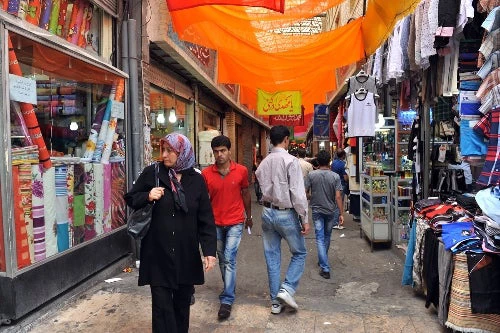Guest blogger, Professor Amin Mohseni-Cheraghlou looks at the internal economic challenges Iran will have to confront to reap any of the potential benefits from the lifting of sanctions.
 The nuclear agreement between Iran and the “P5+1” has finally reached adoption stage - and there is much excitement on economic fronts. Multinationals from around the world are queuing up to gain access to Iran’s market of more than 70 million people, many of whom have an appetite for Western goods!
The nuclear agreement between Iran and the “P5+1” has finally reached adoption stage - and there is much excitement on economic fronts. Multinationals from around the world are queuing up to gain access to Iran’s market of more than 70 million people, many of whom have an appetite for Western goods!
Furthermore, Iran’s young, tech savvy population, and its rich endowment of energy and other natural resources, are reasons for excitement, too, as they can create the ideal atmosphere for more Foreign Direct Investment (FDI) in Iran’s capital thirsty economy.
Much of the excitement ends there, however, as Iran’s economy has been suffering from a number of structural problems for decades. Among many, two problems stand out: one is its crippling bureaucracy and the other, corruption and embezzlement.
First, crippling bureaucracy. According to World Bank’s Ease of Doing Business Ranking, Iran is one of the hardest economies in which to establish a business and operate it. In 2014, it ranked number 130 out of 189 countries, just above Tanzania and Ethiopia and below Mozambique and Pakistan. Such an unfavorable business environment will create serious obstacles for multinationals seeking FDI opportunities and other business opportunities in Iran.
Although development economists agree that efficient and effective institutions are pre-requisite for long-term economic development and growth, Iran has done little toward this. Iran should have started reforming its bureaucracy over the past decade when, faced with increasing US and EU sanctions, it had to become more efficient. But not much progress has been made on this front yet, and nothing serious can be seen in horizon in terms of overhauling Iran’s bureaucracy any time soon.
Second, corruption and embezzlement. Clearly, one imagines a strong correlation between Iran’s inefficient and complex bureaucratic structures and its level of corruption. Over the past few years, high-profile cases of corruption, embezzlement, and bribery—as well as of illegal access to huge sums of bank credit—have been unveiled. In some cases, government officials, their close relatives or colleagues have been arrested and convicted.
Although Iran’s judiciary is taking a tougher stand against corruption, it is a deep-rooted problem, presenting itself at all levels of Iran’s social, political and economic life. Thus, despite repeated calls by Iran’s Supreme Leader, Ayatullah Ali Khamenei (1989–), to address the issue of corruption and embezzlement in a more serious manner, real progress on this front will be piecemeal at best, as the focus have been on confronting corruption and embezzlement after they take place and not on reforming the current institutional and incentive structures that have been making the environment ripe for corruption and embezzlement to take place.
There is no simple solution for addressing these problems, characteristic of rentier states where the bulk of the economy depends on the export of commodities, such as oil. However, if Iran is eager to see the economic benefits of removing some or all of the many economic and financial sanction reach its general population, it has to take these issues seriously.
Otherwise, two outcomes are likely. One is that, with the relaxation of economic and financial sanctions, capital will become more mobile and we could see a net capital flow out of Iran and into stable economies offering better, more secure returns. And two, is that established and well connected individuals and companies will end up reaping most of the benefit from the lifting of sanctions by flooding Iran’s market with imported luxury goods, which will also put pressure on the country’s hard currency reserves.
Not only will these outcomes exacerbate corruption and inequalities of power and wealth in Iran’s society, they will also undermine Iran’s less efficient, capital-thirsty industries, ranging from agriculture to automobile manufacturing. This will jeopardize the living standards of the millions of Iranians employed in domestic industries, posing a challenge for President Hassan Rouhani (2013–) and his promise of improvement of economic conditions for the public at large after the removal of sanctions.
In the end, and as Ayatullah Khamenei and many other Iranian officials have pointed out, the main causes of Iran’s economic problems come from within the country and have little to do with the sanctions. It would be naïve to think that the possible removal of sanctions without major, internal structural economic reforms could achieve much in the way of improving the economic plight of the Iranian public.
Therefore, instead of focusing too much on the removal of sanction as the ultimate important factor in improving the economic conditions of the masses, Iranian officials should focus their energy and resources to address the many internal and structural issues that have been undermining Iran’s economy for many decades, putting inefficient bureaucracy and deeply rooted corruption on top of their list.
 The nuclear agreement between Iran and the “P5+1” has finally reached adoption stage - and there is much excitement on economic fronts. Multinationals from around the world are queuing up to gain access to Iran’s market of more than 70 million people, many of whom have an appetite for Western goods!
The nuclear agreement between Iran and the “P5+1” has finally reached adoption stage - and there is much excitement on economic fronts. Multinationals from around the world are queuing up to gain access to Iran’s market of more than 70 million people, many of whom have an appetite for Western goods!
Furthermore, Iran’s young, tech savvy population, and its rich endowment of energy and other natural resources, are reasons for excitement, too, as they can create the ideal atmosphere for more Foreign Direct Investment (FDI) in Iran’s capital thirsty economy.
Much of the excitement ends there, however, as Iran’s economy has been suffering from a number of structural problems for decades. Among many, two problems stand out: one is its crippling bureaucracy and the other, corruption and embezzlement.
First, crippling bureaucracy. According to World Bank’s Ease of Doing Business Ranking, Iran is one of the hardest economies in which to establish a business and operate it. In 2014, it ranked number 130 out of 189 countries, just above Tanzania and Ethiopia and below Mozambique and Pakistan. Such an unfavorable business environment will create serious obstacles for multinationals seeking FDI opportunities and other business opportunities in Iran.
Although development economists agree that efficient and effective institutions are pre-requisite for long-term economic development and growth, Iran has done little toward this. Iran should have started reforming its bureaucracy over the past decade when, faced with increasing US and EU sanctions, it had to become more efficient. But not much progress has been made on this front yet, and nothing serious can be seen in horizon in terms of overhauling Iran’s bureaucracy any time soon.
Second, corruption and embezzlement. Clearly, one imagines a strong correlation between Iran’s inefficient and complex bureaucratic structures and its level of corruption. Over the past few years, high-profile cases of corruption, embezzlement, and bribery—as well as of illegal access to huge sums of bank credit—have been unveiled. In some cases, government officials, their close relatives or colleagues have been arrested and convicted.
Although Iran’s judiciary is taking a tougher stand against corruption, it is a deep-rooted problem, presenting itself at all levels of Iran’s social, political and economic life. Thus, despite repeated calls by Iran’s Supreme Leader, Ayatullah Ali Khamenei (1989–), to address the issue of corruption and embezzlement in a more serious manner, real progress on this front will be piecemeal at best, as the focus have been on confronting corruption and embezzlement after they take place and not on reforming the current institutional and incentive structures that have been making the environment ripe for corruption and embezzlement to take place.
There is no simple solution for addressing these problems, characteristic of rentier states where the bulk of the economy depends on the export of commodities, such as oil. However, if Iran is eager to see the economic benefits of removing some or all of the many economic and financial sanction reach its general population, it has to take these issues seriously.
Otherwise, two outcomes are likely. One is that, with the relaxation of economic and financial sanctions, capital will become more mobile and we could see a net capital flow out of Iran and into stable economies offering better, more secure returns. And two, is that established and well connected individuals and companies will end up reaping most of the benefit from the lifting of sanctions by flooding Iran’s market with imported luxury goods, which will also put pressure on the country’s hard currency reserves.
Not only will these outcomes exacerbate corruption and inequalities of power and wealth in Iran’s society, they will also undermine Iran’s less efficient, capital-thirsty industries, ranging from agriculture to automobile manufacturing. This will jeopardize the living standards of the millions of Iranians employed in domestic industries, posing a challenge for President Hassan Rouhani (2013–) and his promise of improvement of economic conditions for the public at large after the removal of sanctions.
In the end, and as Ayatullah Khamenei and many other Iranian officials have pointed out, the main causes of Iran’s economic problems come from within the country and have little to do with the sanctions. It would be naïve to think that the possible removal of sanctions without major, internal structural economic reforms could achieve much in the way of improving the economic plight of the Iranian public.
Therefore, instead of focusing too much on the removal of sanction as the ultimate important factor in improving the economic conditions of the masses, Iranian officials should focus their energy and resources to address the many internal and structural issues that have been undermining Iran’s economy for many decades, putting inefficient bureaucracy and deeply rooted corruption on top of their list.


Join the Conversation